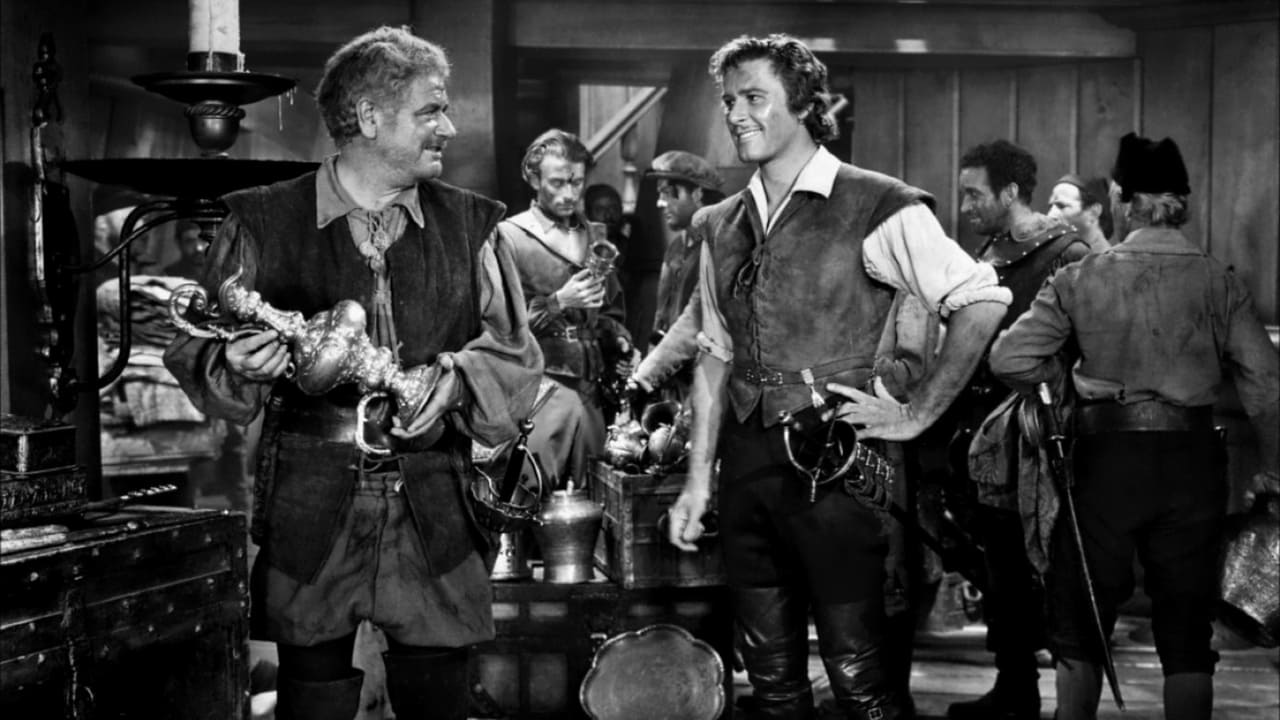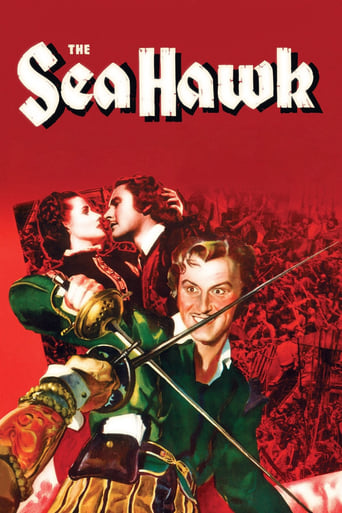

Best movie ever!
... View MoreThis movie was so-so. It had it's moments, but wasn't the greatest.
... View MoreWorth seeing just to witness how winsome it is.
... View MoreGreat movie. Not sure what people expected but I found it highly entertaining.
... View MoreNOTES: Originally it was intended to remake the 1924 version of Sabatini's novel. Delmer Daves prepared a script. However, this idea was scrapped. Instead an original screenplay, "Beggars of the Sea", by Seton I. Miller, revised by Howard Koch, was used. (This was Koch's first screenplay. He had signed with Warners on the strength of his sensational radio script for "War of the Worlds".)In the climactic sword duel, Flynn was doubled by Don Turner and Henry Daniell by both Ned Davenport and Ralph Faulkner. Negative cost: $1,700,000. Shooting commenced 1 February 1940 and took 68 days (20 behind schedule), finishing 19 April 1940.Nominated for the following Academy Awards: Art Direction (black-and-white), Sound, Music Score, and Special Effects. (These awards were respectively won by Pride and Prejudice, Strike Up the Band, Tin Pan Alley and The Thief of Bagdad.)COMMENT: Arguably the best of Flynn's swashbucklers, The Sea Hawk is an ingratiatingly acted, superbly paced and marvelously expensive tale, embellished by Curtiz's forceful direction, Polito's stunning photography and Korngold's rousing, welcomely intrusive score. Money has been spent like pirate gold on extras, costumes and sets. Even without knowing the budget, it's obvious the film has been realized with enormous care and craftsmanship.Flynn makes a gentlemanly Thorpe. His scenes with Robson have an unusual and special flavor, a delightful parrying which producer Wallis did not appreciate because these lines were adlibbed by Koch, Flynn and Curtiz on the set. Wallis hated tinkering with the script and also tried to hold back the director's constant attentions to the fight and action scenes. In both respects, he was unsuccessful. Curtiz's varied camera set-ups with their strikingly in-depth compositions and his dramatically inventive angles (the thrilling overhead pan along the deserted ship as Flynn and his buckos climb back aboard) lend the whole film a wonderful atmosphere of high-spirited derring-do and romantic excitement.Fortunately the love interest doesn't get in the way of the lavishly-staged action. No wonder Olivia de Havilland turned the part down! Newcomer Brenda Marshall (she had made only one previous film: Espionage Agent) was assigned. She's capable enough but lacks charisma and color. Nonetheless, this role was probably the high point of her career. (In real life, she married William Holden in 1941, retired from pictures in 1943, made a brief comeback in 1949 and 1950.)Due to Curtiz's skill, none of the film's production problems show up on the screen. Henry Daniell was reportedly "absolutely helpless" with a sword. He is obviously doubled in the long shots, but the close-ups are quite effective and that is Flynn himself the double is often dueling! With that sonorously evil voice of his, Daniell really makes a marvelous villain, completely wiping the floor with poor old Donald Crisp (whose part is pretty small to boot). His co-conspirator, the satanically costumed Claude Rains, also has a high time, while Francis McDonald likewise shines as a properly slimy henchman.Alan Hale and Una O'Connor reprise their usual sidekick roles, William Lundigan (later to become a rather dreary if minor leading man) is reasonably effective in a small spot as one of Thorpe's crew (a group which includes a meatier characterization for J.M. Kerrigan and a surprisingly piddling bit for Edgar Buchanan). Gilbert Roland's role is also not over-large, though it's important enough to give us a sense of disappointment that his acting is slightly wooden. Among the character players, Halliwell Hobbes and particularly Alec Craig deserve our full admiration.It's interesting that some of the cleverly effective directorial touches we remember from the film (the close-up of the spinning globe with Hobbes' voice off-camera) turn out from an examination of the written screenplay to be Koch's devices not Curtiz's. Yet Curtiz alone embell¬ished the scene on the deserted ship with that stunningly dramatic overhead shot. What is more, Curtiz (and Korngold) have given the whole scene much greater atmosphere (and length). Our only complaint with his direction is that very occasionally he falls back on old-fashioned tricks like speeding up the action by under-cranking the camera. These obvious lurks date the film and actually lessen its impact. Fortunately, there are few of them. The miniature ships are maybe just a tiny bit obvious too, though quick cutting helps their disguise. A few snips of "old" stock footage are also thrown into relief by Polito's superbly contrasted "new" photography.Quibbles aside, The Sea Hawk is one of the great sea-sword-and-cannon entertainments of the cinema. Basil Rathbone fans were naturally disappointed their champion (who was incidentally first choice for the role) somehow missed out on Wolfingham, but Daniell's impersonation in my opinion is equally enthralling. As for the broodingly atmospheric sets, the edge-of-the-seat film editing (e.g. the intricate intercutting between Marshall and Flynn in the sequence in which she misses the sailing of "The Albatross"), and the dazzling panache of Curtiz's direction, who would deny (or forego) such excitement? The Sea Hawk's appeal is the same as Robin Hood's or Captain Blood's: White is right. The dashing spirit of romance and adventure is seen to triumph splendidly over all the machinations of enemy and fate.Acted with enthusiasm and realized on the grandest of scales, The Sea Hawk is a masterpiece of cinematic enchantment.
... View MoreThis is a rousing epic type movie and for 1940 you sure got your monies worth when you went to the theater to see this. Grab a bite, a friend and some snack and this was a premium night out. How can you miss with Errol Flynn? It also has a nice supporting cast and everyone gives their all for the audience. If all that is not enough, you get some history thrown in too. Whatever the magic that was at work back then is surely gone today with few exceptions. People would flock to the movies to see quality films on big screens but alas they are becoming scarcer and in its stead, cable, streaming and cheap flicks are upon us all. The classics remain however and are perfect for your collection. Include this fine movie. BTW...they define what a 'sea hawk" so relax and ....
... View MoreGreat naval adventure, set at the time of the Spanish Armada. Entertaining, with a solid plot and great, and quite realistic, action scenes. Considering this was made in 1940, the recreations and special effects are amazing. No CGI, good old fashioned real ships.Errol Flynn was perfect for the lead role: dashing, swashbuckling, charming. Easily his best movie. Good support from Brenda Marshall and Flora Robson (as Queen Elizabeth I).A classic.
... View MoreEverything is right in this film loosely based on the exploits of Sir Francis Drake and very little on the Rafael Sabatini novel. Errol Flynn, Claude Rains, Michael Curtiz, Erich Wolfgang Korngold, The WB Banner and piracy on the High Seas – What more could one ask for? Obviously the answer would be "The Sea Hawk". The only shortcoming to my knowledge was no Olivia de Havilland who for some reason was overlooked by Jack L Warner when he made the film. Flynn is at his dashing best as the fictionalised Geoffery Thorpe matching wits with the likes of King Philip of Spain and his treacherous agents . He matches swordplay, tongue in cheek and romance with ease making this his best ever. Claude Rains and Henry Daniel are unpleasantly debonair in their roles of Spanish spies. Brenda Marshall is adequate but just does not match up as one is always wishing Olivia alongside Errol as his lady love. Flora Robson re-creates her role as Elizabeth I and adds a great aura of grace and majesty in her depiction. One cannot but help feeling that her rendition is of such conviction that it makes one believe that Elizabeth could not but have spoken and behaved the way in which she is played. Michael Cutriz once again scores with his excellent action sequences but overall it is Korngold who enthralls the viewer with his sweeping score which is unforgettable. One cannot but recollect the similarities of this film to "Fire Over England" but the Hollywoodization of medieval England is more pronounced here. Some unforgettable scenes: The beginning of the film – the shadow of a dictator (Philip of Spain) covering the map of Europe wanting to covet England and her colonies bears a striking resemblance to Hitler and his dream all the more significant as the film was released in early 1940 when the Phoney war had just begun and Dunkirk was in the near distance. The swordplay between Flynn and the Spanish captain where he points out that the English are a practical people who do not sink with their ships – a veiled message to the Nazis that Britain would fight on even if all Europe was to fall? The speech by the Queen towards the end of the film where she warns her subjects of being prepared for the Armada that was poised to strike ( Hitler's Luftwaffe and The Battle of Britain) and a distant appeal to America to join the fight against Fascism. Last but not least the scene where the freed slaves of the Spanish Galley look wistfully at the distant Cliffs of Dover and ex- slave Tuttle mouths just one word "England" which to me was the émigré Curtiz announcing to all of downtrodden Europe that their safe haven in the wake of the impending onslaught was indeed Britain. One can go on and on about Sea Hawk but a review needs to be concise. The greatest of a swashbuckler that does not age a bit and can be viewed over and over again.
... View More